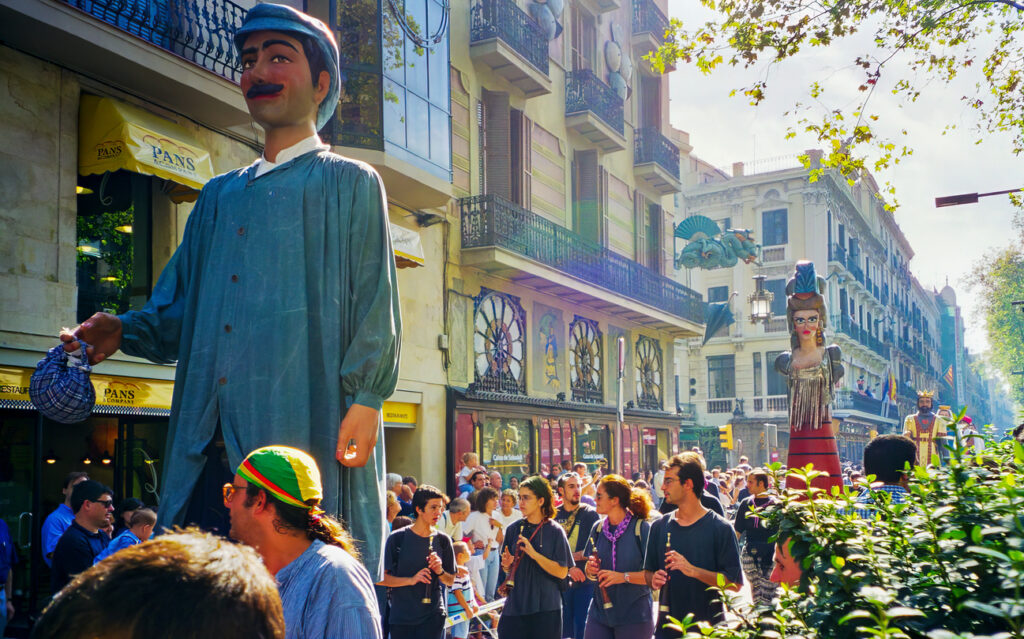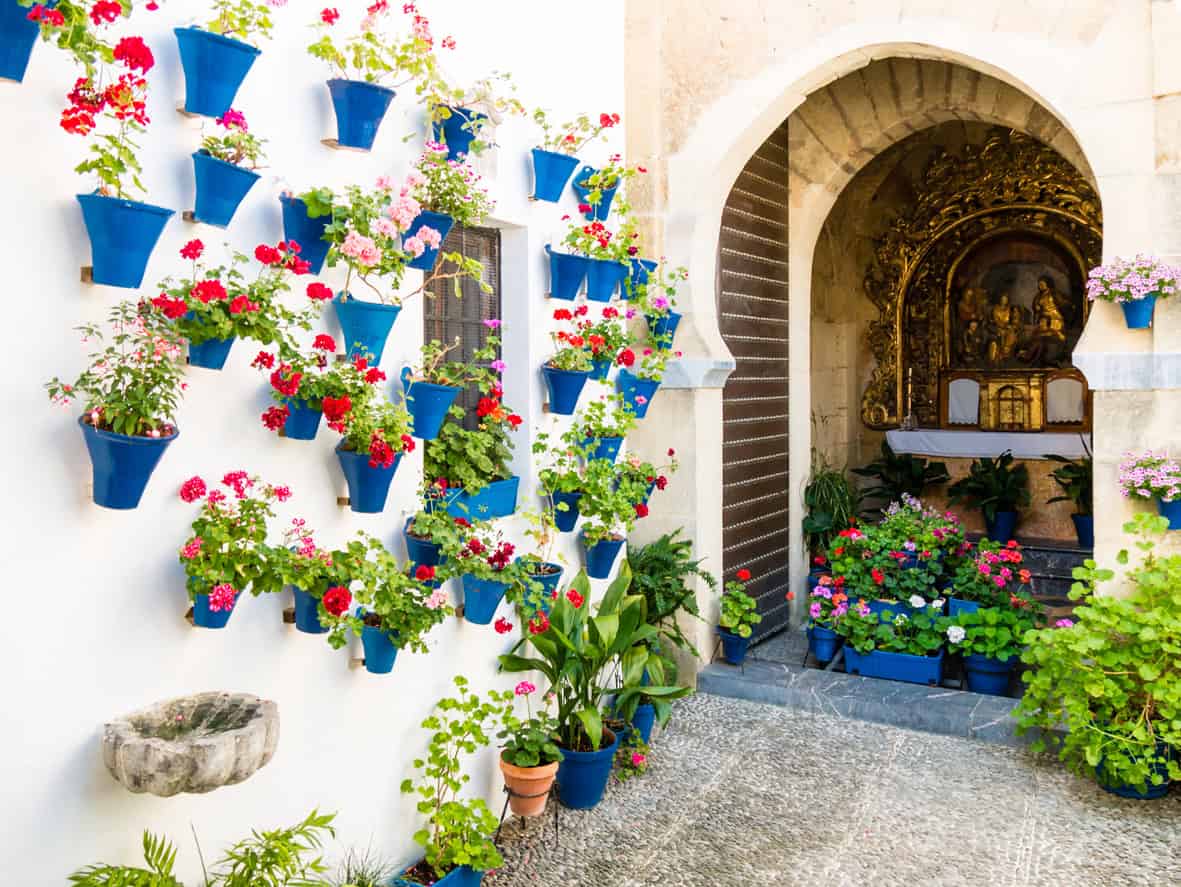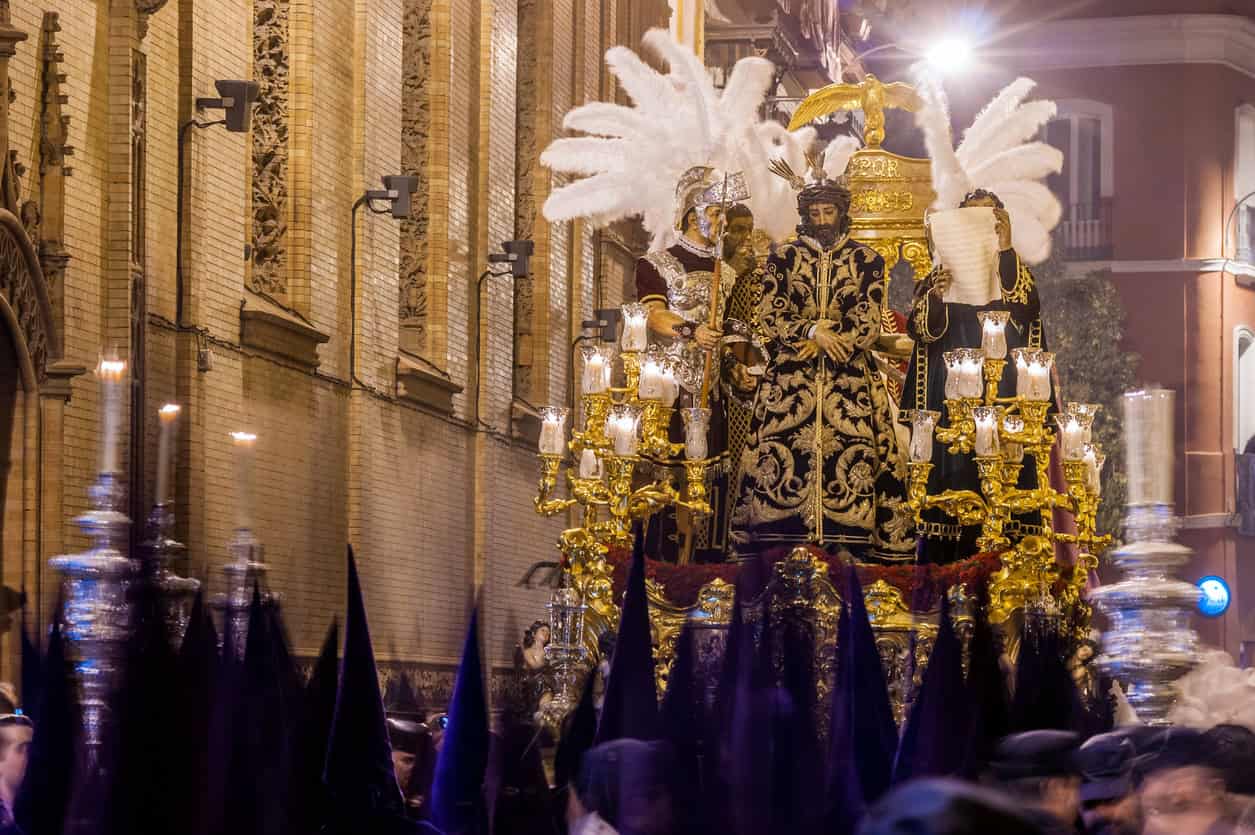Spain in the fall trades heat for heart. The crowds fade, but the festivals? They’re just getting started. Fall festivals in Spain lean local, rooted in harvests, music, fire, and food that actually matters. No pretense, no performance—just real tradition and good energy.
This guide gets straight to it: what each festival is about, how to get there, where to stay (with real hotel picks), and what to eat that doesn’t taste like regret. Let’s go.

*Note some of the links feature affiliate links. I only recommend items that I 100% love and think you will too!
1. La Mercè – Barcelona
Overview:
Barcelona’s La Mercè, typically around September 24, marries Catalan tradition with just the right amount of flourish. Expect castellers (human towers), giant puppets, street parades, and fireworks that feel magnetically inevitable.
Details:
- Key dates: Around September 24 — check the official Barcelona tourism site annually for exact timing.
- Where to get tickets: Most events are free. Reserved performances (like concerts at Palau de la Música) require booking via official platforms like Turismo de Barcelona.
- How to get there: Fly into Barcelona–El Prat. Take the Aerobús or metro L9/L10 to Plaça de Catalunya; from there, it’s an easy walk across the Gothic Quarter or Eixample.
- Where to stay: Stay near El Born or Gràcia for charm and proximity. For instance, try Hotel Neri, a cozy boutique gem tucked into the Gothic Quarter with a rooftop terrace perfect for festival comings and goings
- What to do: Watch the castellers at Plaça Sant Jaume, stroll through the Parade of Giants, linger over a casually pulled sardana in a sunlit square.
- What to eat: Go for anchovies on pa amb tomàquet, street-side churros with rich hot chocolate—especially from a stall that feels “known” by someone who lives here.
Read about what else to do in the Gothic Quarter here.
2. Feria de San Miguel – Seville
Overview:
At the end of September into early October, Seville’s Feria de San Miguel unfurls in a soft swirl of horse-drawn carriages, flamenco rhythms, and jamón sliced so paper-thin you swear you’ll taste the air.
Details:
- Key dates: Approximately between September 23 and October 3—verify each year via Seville’s event calendar.
- Where to get tickets: Most casetas (tents) let you in with a smile. Some private ones need invites or local liaisons.
- How to get there: Fly into Seville Airport, then taxi or tram to the Real de la Feria grounds.
- Where to stay: For genuine local flair, stay in Triana or near Alameda. I recommend a stay at Las Casas de La Juderia—a charming boutique hotel made up of interconnected 15th-century houses and courtyards in the old Jewish quarter, offering an authentic Andalusian atmosphere.
- What to do: Tap your foot in a flamenco tent, watch the horse parades, browse local crafts, catch impromptu tunes on hidden corners.
- What to eat: Jamón ibérico, tortilla de patatas, and sweet carafes of wine, all with cervezas that come in whisper-sized glasses.
3. Festival of San Froilán – Lugo
Overview:
Early October in Lugo (usually around October 7–15). This festival brings chestnuts crackling, tractors on parade, and bonfires that feel uncontrived—just earthy warmth with good company.
Details:
- Key dates: Early October; usually around October 7–15—double-check via official Lugo festival information.
- Where to get tickets: The festival streets and events are mostly free; special exhibits might charge and require booking locally.
- How to get there: Fly into A Coruña or Santiago de Compostela, then take a train or car to Lugo.
- Where to stay: Stay inside Lugo’s ancient walls to soak in historic weight. For example, Hospedería San Froilán is just steps from the old city and known for excellent service and breakfast.
- What to do: Roast chestnuts with locals, follow the tractor parade, sip regional Albariño wines in candlelit lanes.
- What to eat: Cacheiras (chestnuts), empanadas, and pulpo a feira satisfy more than hunger—they connect you to place.
4. BIME Live & BIME Pro – Bilbao’s Autumn Music Pulse
Overview:
When October rolls in, Bilbao echoes with more than classical—it innovates. BIME brings together music lovers and industry insiders with a festival that bridges live shows and creative seminars in the same city rhythm.
Details:
- Key dates:
- BIME Live: Free concerts and showcases—usually late October to early November, roughly October 29 to November 2.
- BIME Pro: Industry-focused workshops and talks nestled around the same period
- BIME Live: Free concerts and showcases—usually late October to early November, roughly October 29 to November 2.
- Where to get tickets:
- BIME Pro: Registration opens via the official festival portal—includes talks, networking, and pro showcases
- BIME Pro: Registration opens via the official festival portal—includes talks, networking, and pro showcases
- How to get there:
- Fly into Bilbao Airport; the city’s transit—metro, buses—easily takes you to multiple BIME venues.
- Fly into Bilbao Airport; the city’s transit—metro, buses—easily takes you to multiple BIME venues.
- Where to stay:
- Hotel Miro remains a smart choice—minimalist design, stellar location, and riverside comfort near concert zones.
- Hotel Miro remains a smart choice—minimalist design, stellar location, and riverside comfort near concert zones.
- What to do:
- Mix pro panels with rock or indie showcases. Wander the Grand Via, grab pintxos between sessions, soak in the Guggenheim’s pressured calm, and maybe catch a late-night DJ set.
- Mix pro panels with rock or indie showcases. Wander the Grand Via, grab pintxos between sessions, soak in the Guggenheim’s pressured calm, and maybe catch a late-night DJ set.
- What to eat:
- Pintxos are still king—oddly small, wildly flavorful boozy bites at every corner. Think chistorra, anchovies, local cheeses.
- Sip cider or txakoli like the locals do—in small glasses, with small conversations, between beats.
- Pintxos are still king—oddly small, wildly flavorful boozy bites at every corner. Think chistorra, anchovies, local cheeses.
5. Fiesta de la Vendimia – Requena (Valencia Region)
Overview:
In Spain’s Valencia interior, the Fiesta de la Vendimia in Requena turns grape harvest into a full-sensory weekend—from foot-stomping vats to wine-blessed rituals and fire‑lit parades under starlit skies.
Details:
- Key dates: Typically spans late August to early September
- Where to get tickets: Most events—grape treading, parades, tastings—are free and open to all. Guided tours and winery events may require booking via tourism pages or local wineries.
- How to get there: Drive or take the train from Valencia city to Requena (approximately 1 hour inland).
- Where to stay: Stay at Hotel Finca Calderón Enoresort—a restored early-20th-century winery nestled among Requena’s vineyards. It blends quiet luxury with wine heritage, and puts you a grape’s throw from everything.
- What to do: Kick off the festival with the Pisá de la Uva—a barefoot stomp for the first must, followed by the ceremonial offering to the Virgen de los Dolores. Then join the Cabalgata del Vino, a wine-themed parade with floats and costumes. Wrap the evening with the “Noche del Vino,” live music, fireworks, and the “Noche del Labrador” gala under candlelight.
- What to eat: Expect embutidos (cured sausages), ajoarriero (garlicky fish mash), and the region’s famed bollo de Requena—a savory pastry that pairs beautifully with local Bobal wines.
Use My Map to Find Your Hotel
Got your festival route mapped out but still figuring out where to sleep? Use my interactive hotel map—it’s a no-fuss way to browse solid hotel options across Spain, whether you’re staying in the thick of a festival or just passing through.
Check out the map → Click below to open the Spain Hotel Finder Map
6. Festival de Cine de San Sebastián
Overview:
Each September, this coastal Basque gem pulls out red carpets and rough seas for Spain’s premier international film festival. You won’t just watch films—you’ll walk past directors smoking nervously, critics debating espresso in hand.
Details:
- Key dates: Typically runs from September 19–27 each year.
- Where to get tickets: Festival passes and individual tickets are sold online via the official San Sebastián Film Festival website.
- How to get there: Fly into Bilbao or Biarritz, then shuttle or Renfe train into San Sebastián.
- Where to stay: For old-school elegance close to all the screenings, Hotel de Londres y de Inglaterra overlooks La Concha Bay and feels like it was built for film noir (hlondres.com).
- What to do: Catch screenings across theaters, walk the promenade, join panel discussions or casual meet-ups at pintxo bars.
- What to eat: Basque cheesecake, grilled octopus, pintxos stacked with jamón or foie—all easily paired with a glass of txakoli.
7. Otoño Mágico – Salamanca
Overview:
In Salamanca, fall is less heard than seen. The Otoño Mágico lights up buildings with storybook projections—history rendered in motion, not pages. It’s humble, evocative, and weirdly addictive.
Details:
- Key dates: Takes place throughout October, often peaking mid-to-late month.
- Where to get tickets: Most events are free; exhibitions and guided tours may require sign-up through Salamanca’s cultural bureau.
- How to get there: Fly into Madrid, then take a 1.5-hour train or drive northwest to Salamanca.
- Where to stay: Stay near the Plaza Mayor or University District. For a splurge that feels earned, try Grand Hotel Don Gregorio—a former palace turned into a chic 17-room boutique stay (hoteldongregorio.com).
- What to do: Watch digital projections across cathedral facades, tour old university libraries, browse artisanal markets in the square.
- What to eat: Hornazo (meat pie), local jamón, sheep cheese with quince, and aged local red wine.
8. Fiesta de la Vendimia – La Rioja
Overview:
La Rioja’s Vendimia Festival isn’t just a toast—it’s a hands-on harvest ritual. You stomp, you swirl, you clink. Here, wine doesn’t demand respect—it earns it through grape-stained shoes and tablefuls of friends.
Details:
- Key dates: Late September, most famously September 21–30.
- Where to get tickets: Public events in Haro and Logroño are free. Winery tours or tastings need advance booking.
- How to get there: Fly into Bilbao or Madrid; train or drive into Logroño or Haro.
- Where to stay: In Haro, Hotel Los Agustinos, a former convent turned hotel with a dramatic cloistered courtyard, adds just the right note of historical flair (hotellosagustinos.com).
- What to do: Join grape-stomping rituals, explore local bodegas, raise a toast in a medieval square.
- What to eat: Lamb chops grilled over vine shoots, patatas a la riojana, and enough Rioja wine to fill your camera roll with blurry joy.
9. Día de Todos los Santos – Spain-Wide
Overview:
November 1 across Spain softens the fall noise. Families visit cemeteries with marigolds, whisper stories, and offer up sugar-sweet bones to the memory of the dead. It’s not a performance—it’s presence.
Details:
- Key date: November 1st, every year.
- Where to get tickets: None needed—this is about tradition and family.
- How to get there: Accessible from any Spanish city. If you’re in a pueblo, it’ll feel even more sincere.
- Where to stay: Stay near a small town for the richest experience. In Segovia, for example, Hotel Real Segovia offers an old-world setting with castle views and thoughtful touches
- What to do: Visit local cemeteries, attend All Saints Day mass, quietly observe with others.
- What to eat: Huesos de Santo (almond-filled pastries), panellets (marzipan balls), roasted chestnuts, and sweet local wine.
10. Fiesta Nacional de España – Madrid / Nationwide
Overview:
Spain’s national day, October 12, is all military parades and civic pride. It doesn’t scream—it marches. Flags rise, families gather, and Madrid’s streets become part of a slow, formal heartbeat.
Details:
- Key date: October 12th, Spain’s National Day.
- Where to get tickets: The parade is public; box seats may be available via official tourism offices or hotels.
- How to get there: Fly into Madrid. Events happen across the Paseo de la Castellana and Plaza de Colón.
- Where to stay: For views of the route and proximity to everything, Only YOU Hotel Atocha balances modern cool with regal bones (onlyyouhotels.com).
- What to do: Watch the parade, sip vermouth after, or escape the bustle with a slow walk through Retiro Park.
- What to eat: Bocadillo de calamares, rich cocido madrileño, and classic tapas paired with vermouth or cañas.
Drop Your Bags with Luggit
Lugging a suitcase through cobbled streets, parades, or vineyard paths? Hard pass. Use Luggit—they’ll pick up your bags wherever you are and drop them off later at your hotel, Airbnb, or even the train station.
How it works:
- Book through the Luggit app
- A “Keeper” picks up your bags wherever you tell them
- They deliver them later, right where you need them
It’s available in major cities like Barcelona, Madrid, Seville, and more. Perfect when check-in is hours away but the festival’s already started.
Get it here: luggit.app
Your back (and your mood) will thank you.
Conclusion:
Fall festivals in Spain aren’t trying to impress—they just are. From roasted chestnuts to wine-stained shoes, they’re honest, alive, and built to be lived in, not looked at.
Skip the rush. Show up in autumn, and you’ll find Spain wide open, warm at the table, and already halfway into a story worth joining.
Frequently Asked Questions About Fall Festivals in Spain
Are there any festivals in October in Spain?
Yes, several popular festivals take place in October in Spain. These include San Froilán in Lugo, Feria de San Miguel in Seville, La Vendimia (wine harvest festivals) in La Rioja, and the national holiday Fiesta Nacional on October 12.
What are the major festivals in Spain?
Major festivals in Spain include La Mercè in Barcelona, San Fermín in Pamplona, Las Fallas in Valencia, Semana Santa (Holy Week), and La Tomatina in Buñol. In fall, highlights include La Vendimia and San Froilán.
Are there any festivals in Spain in September?
Yes, Spain hosts several festivals in September. Notable ones include La Mercè in Barcelona, the San Sebastián International Film Festival, and various wine harvest celebrations in regions like La Rioja and Valencia.
What Spanish holidays are in October?
Spain’s national holiday in October is Fiesta Nacional de España, celebrated on October 12. It features parades and official ceremonies, especially in Madrid. Other local festivals like San Froilán and Feria de San Miguel also occur in October.
Festivals in Spain
Discover the ultimate guides to Spain’s most iconic festivals, including Semana Santa in Seville, San Fermín, La Tomatina, San Isidro, and the Córdoba Patio Festival and more.
Explore Córdoba Patio Festival 2025: A Burst of Color and Culture
Experience the vibrant Córdoba Patio Festival 2025, where stunning floral displays, rich traditions, and local culture bring the city to life.
The Ultimate Guide to Experiencing Semana Santa Seville
Discover the ultimate guide to experiencing Semana Santa in Seville, with insights on processions, traditions, must-see events, and local tips for an unforgettable visit.
Disclaimer: The content on Must See Spain is provided “as is” with no guarantees of accuracy, reliability, or suitability. Travel involves risks, including injury, illness, theft, or unexpected events. Must See Spain is not responsible for any issues encountered during your travels. Always verify information independently and check local sources before making plans.


Comments Off on Top Fall Festivals in Spain That Locals Love